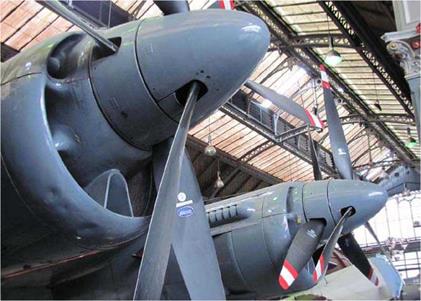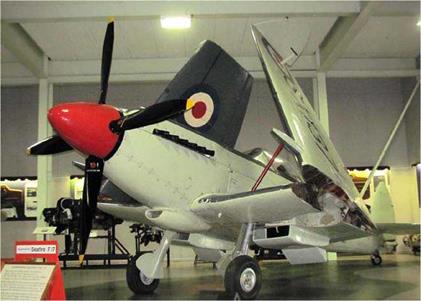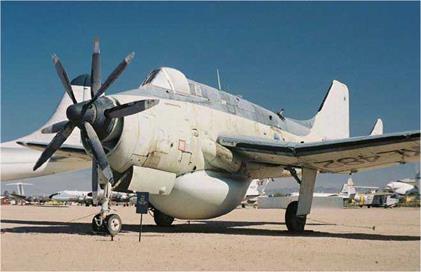Counter & Contra-rotating Props
On twin-engine aircraft, the propellers of each engine may rotate in opposite directions (counter-rotate) to enhance engine out handling. The idea of using counter or contrarotating propellers is not a new one. The Wright brother’s Flyer I built in 1903 had counter-rotating propellers, chain – driven off one engine. The chains were not bicycle chains as some people believed, but were made especially for the Flyer I.
The 11-feet (3.35 m) Curtiss electric props on the Lockheed XP-38 Lightning (1939) experimental fighter rotated top blade in. On the YP-38 Lightning prototype, and all subsequent production models, the prop’s direction of rotation was reversed to rotate top blade out. The result was exceptional longitudinal stability for the P-38.
The Piper Twin Comanche and its bigger brother the Navajo Chieftain, both have counter-rotating props rotating top blade
|
The Avro Shackleton bomber has four engines each powering a set of contra-props. This aircraft is in the Manchester Air Museum, England. |
in towards the fuselage, the conventional way for modern aircraft. An exception was made with the Piper Aerostar 700P; this aircraft has its counter-rotating props turning top blade away from the fuselage, the same direction as on the P-38 and also for stability purposes. Because the blades rotate top blade outwards, the centre of thrust is placed further outboard but the critical engine is still eliminated.
Another aircraft of historical significance with counterrotating propeller is the Shorts S.39 Triple-Twin. The name sounds contradictory until one realizes the layout of the aircraft; the two seat aircraft looks similar in some respects to the Wright Flyer I, with a wing span of 34 feet (10.4 m) and a length of 45 feet (1.7 m). It had two Gnome rotary engines of 50 BHP (37 kW) each, driving three propellers, hence the name Triple-Twin. The engines were mounted in tandem in the fuselage; the front engine powered two tractor, counterrotating propellers by chain drive, similar to the Flyer I, while the rear mounted engine powered a single pusher prop. The Triple-Twin first flew on 18 September 1911, to become the world’s first aircraft driven by three propellers, albeit with only two engines, the forerunner of the push/pull arrangement found on later aircraft. On 13 May 1913, the flight of the world’s first four-engine aircraft occurred; this was the Bolshoi Baltiski (Grand Baltic 1) developed by Igor Sikorski. First designed as a twin-engine biplane that was underpowered, two more engine and propellers were added in tandem with the original Argus engines, each of 100 BHP.
A contra-rotating propeller (or contra-prop for short) is one that consists of two co-axial mounted propellers and driven by the same engine, but rotating in opposite directions. With this arrangement, the total amount of power absorbed by the propeller can be greatly increased. Contra-props also date back to the early days of flying. At least as far back as 1909 when the Piggott brothers built their Piggott biplane with a contra – prop. [There could have been others before this one, but not
|
A Supermarine Seafire F.17 with a four-blade propeller, similar to the Seafire mentioned in the text. This aircraft is located in the Fleet Air Arm’s Naval Air Station Air Museum, Yoevilton, England. |
to this author’s knowledge]. The two props on the Piggott were well spaced being about 3 feet (1 m) apart. Conventional contra-props are placed adjacent to each other as shown in the photograph of the Avro Shackleton.
A Deperdussin with a contra-prop followed the Piggott’s biplane in 1912 . Moreover, 1944 saw the appearance of the experimental Boeing XF8-B1 carrier-based fighter/bomber powered by a contra-prop. It never passed the experimental stage and so, did not make it into military service.
In 1944-45, a Supermarine Spitfire XIV was flight tested for 230 hours with a six-blade contra-rotating propeller installed. The first flight was performed in August 1944 and was followed by the carrier based naval version of the Spitfire – the Seafire 47. A Rolls Royce Griffon engine of 2350 BHP driving a six-blade contra-prop powered the experimental Seafire. This was a substantial increase in power from the early ‘Mark’ of Spitfire’s engines of 1000 BHP driving a two-blade propeller.
Four years later, The UK’s Fleet Air Arm’s Fairey Gannett prototype became the world’s first contra-prop equipped aircraft to be powered by a turbine engine – the Armstrong Siddeley Double Mamba 2950 ESHP turboprop powered the eight-blade contra-rotating propeller. The Gannett’s first flight took place on 19 September 1949. It went on to make further aviation history on 19 June 1950 when it became the first turboprop aircraft to make a carrier landing; the ship was the HMS Illustrious.
The prototype Bristol Brabazon piston-engine airliner was another contra-rotating propeller equipped aircraft worthy of note. Its eight Bristol Centaurus engines each producing 3500 BHP, were coupled in pairs; each powered an eight – blade Rotol contra-prop. After 400 hours of flight-testing over a period of four years, the prototype was scrapped. Its
|
An example of the AEW-3 version of the Fairey Gannet. The Pima Air & Space Museum in Tucson, Arizona, is home to this aircraft. |
demise was initiated by the high cost of development and the fact the DeHavilland Comet 1 jet airliner made its maiden flight about six weeks before the Brabazon’s first flight, which was accomplished on 4 September 1949. The end of the large piston powered airliners had finally arrived; jets were here to stay!
Moving on to larger aircraft… The Russian built Antonov AN-22 Antheus (1965) was for a short time the world’s largest aircraft until the arrival of the Boeing 747 and the Lockheed C-5A Galaxy military transport. The An-22 is powered by the world’s largest turboprop engines; these are the Kuznetsov NK-12MA fixed-shaft engines developing an incredible 15,000 Shaft Horsepower (11,185 kW) each. The four engines each drive massive 20 feet 4 inch (6.2 m) eight-blade contra-props at a very low 750 RPM, and producing a very distinctive noise in the process. As a further point of interest, the AN-22’s props are very large but they are not the largest propellers to be used. Although it was not a contra-prop, the record for the world’s largest propeller goes to the 22 feet 8 inch (6.9 m) Garuda prop. The Garuda was mounted on the German designed, Polish built Linke-Hoffmann R-11 prototype aircraft, with a first flight on 19 January 1919. It looked like a single-engine aircraft on steroids, but had a wing span of 138 feet 4 inches (42.25 m) and a length of 66 feet 8 inches (20.2 m). Compare this to the wing span of an early Boeing 737 at 93 feet (28.35 m). The single Garuda prop was powered by four Mercedes D. IVa of 260 BHP engines each, giving a maximum speed of 81 MPH. Due to the propeller’s large diameter, it turned at a very low 545 RPM. Only the one prototype was ever completed.














